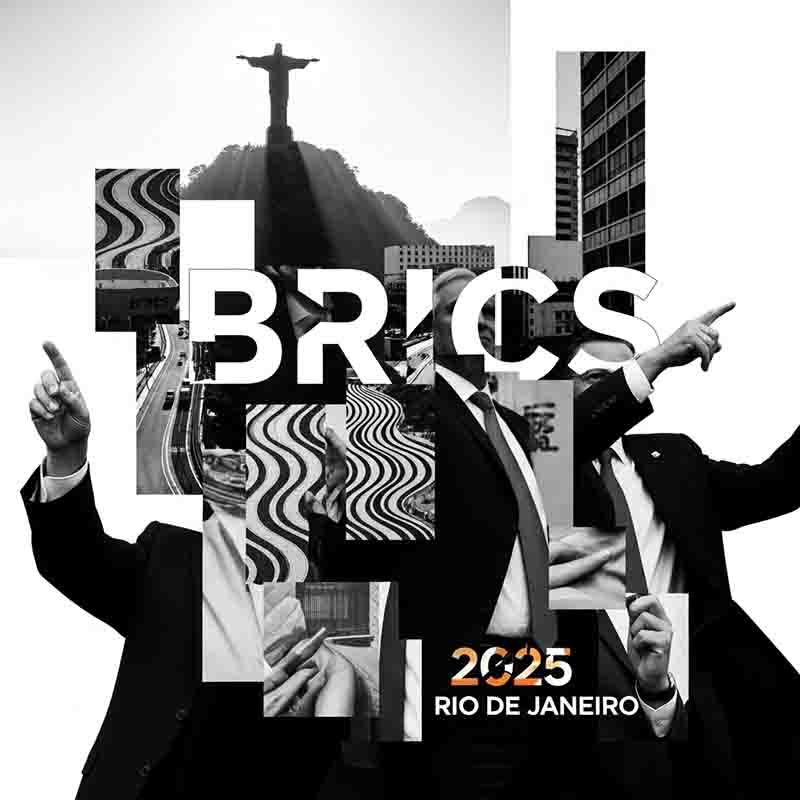Expansion, Cooperation, and a Strategic Shift in Global Governance
The 2025 BRICS Summit took place in Rio de Janeiro, Brazil, from July 6 to 7. It focused on expanded membership, multilateral cooperation, economic reform, AI governance, climate finance, and inclusive global development.

The 2025 BRICS Summit delivered clear messages: the bloc is growing, its influence is expanding, and its members are more organized in setting shared goals.
BRICS Expands Again: Is the West Losing Influence?
The 2025 BRICS Summit, held from July 6 to 7 in Rio de Janeiro, marked a turning point for the bloc.
With Brazil serving as chair, the summit emphasized stronger cooperation among developing nations and clearer efforts to influence global governance.
This year's theme, “Strengthening Global South Cooperation for More Inclusive and Sustainable Governance,” reflected BRICS's attempt to move beyond rhetoric and toward practical coordination.
The most widely reported outcome was the admission of Indonesia as the 11th full BRICS member and Vietnam as it's 10th partner country.
To manage future growth, members agreed to form a working group to define criteria for admission.
This decision reflects internal differences: China and Russia support rapid expansion, while India, Brazil, and South Africa prefer a slower, rules-based approach.
While internal coordination, economic asymmetries, and geopolitical divisions remain, the Rio summit marked a step toward structuring a multipolar order built on South-South cooperation, shared development, and inclusive governance.
Key Declarations and Strategic Outcomes
The summit concluded with the adoption of the Rio de Janeiro Declaration, a document that outlines 126 commitments across political, economic, environmental, and health-related areas. Highlights include:
-
BRICS Leaders' Framework on Climate Finance: This roadmap focuses on resource mobilization for green development. Members agreed to support efforts like Brazil's Tropical Forest Forever Fund and expand financing for renewable energy projects.
-
AI Governance Statement: For the first time, BRICS addressed global artificial intelligence regulation. Leaders called for a UN-led process to set international standards, with emphasis on fair access and risk management for developing countries.
-
Global Health Cooperation: The launch of the BRICS Partnership for the Elimination of Socially Determined Diseases linked health equity directly to broader sustainable development goals (SDGs). The initiative aims to tackle diseases linked to poverty and exclusion and improve vaccine access and distribution.
-
Policy Focus and Strategic Alignment: While members criticized trade restrictions, widely seen as references to U.S. tariff threats, the bloc stopped short of direct confrontation.
-
Global financial reform: BRICS wants a more balanced system, not a new one altogether.
-
New Development Bank (NDB): Leaders pledged to expand lending in local currencies to reduce dependency on the U.S. dollar and to fund infrastructure and climate-related projects in Global South countries.
-
11th Full Member: Indonesia was formally admitted as the 11th full member of BRICS, joining Brazil, Russia, India, China, South Africa, Saudi Arabia, Egypt, Ethiopia, UAE, and Iran.
-
India to Chair BRICS in 2026: India will assume the 2026 BRICS chairmanship, with expected focus areas including digital infrastructure, cross-border payments, and structured membership expansion rules.
Analysts expect continued debate over digital infrastructure, regional security, and trade integration under the BRICS+ format.
2025 BRICS Summit: Timeline
Hosted by Brazil in Rio de Janeiro, the 2025 summit marked a milestone with the formal admission of Indonesia and the inclusion of 10 partner countries, making it the most inclusive summit to date.
The summit emphasized inclusive global governance and stronger cooperation among Global South nations to address development and economic reform.
| Year | Milestone |
|---|---|
| Jan 1, 2025 | Brazil begins its rotating BRICS chairmanship, setting the agenda for the upcoming summit. |
| Feb 15, 2025 | Brazil confirms Rio de Janeiro as the official host city for the 17th BRICS Summit. |
| July 6-7, 2025 | The summit is conducted at the Museum of Modern Art. Brazil leads discussions on inclusive governance and development. |
| July 7, 2025 | Indonesia is officially admitted as the 11th full member of BRICS. |
| July 7, 2025 | Ten nations, including Nigeria, Vietnam, and Malaysia, are announced as BRICS partner countries. |
| July 7, 2025 | BRICS adopts the Rio de Janeiro Declaration, outlining 126 commitments on climate, AI governance, health, and economic cooperation. |
| July 2025 | BRICS agrees to create a working group to define clear membership criteria and guide future enlargement. |
| 2026 (Upcoming) | India is scheduled to host the 18th BRICS Summit, continuing discussions on digital infrastructure and trade systems. |
This timeline provides a clear view of the formation, growth, and strategic direction of BRICS leading to and following the 2025 BRICS Summit.
At Rio Summit, BRICS Expands Influence While Testing Its Limits
The 17th BRICS Summit, held from July 6 to 7 at the Museum of Modern Art in Rio, marked Brazil’s return to the group’s rotating presidency.
Under the theme “Strengthening Global South Cooperation for More Inclusive and Sustainable Governance,” Brazil aimed to reposition BRICS not as an opposition to Western alliances, but as a platform for alternative leadership in global affairs.
2025 BRICS Summit Expands Bloc, Adds Indonesia as Full Member
The most visible change came with Indonesia’s formal admission as the 11th full member, alongside the recognition of ten new “partner countries,” including Nigeria, Vietnam, and Kazakhstan.
This expansion has nearly doubled the group’s demographic footprint, now representing nearly half the world’s population and 40 percent of global GDP.
BRICS at a Crossroads
Despite the impressive numbers, the growing diversity of members has introduced challenges.
Disagreements over the pace and terms of further expansion, particularly between China, which advocates rapid inclusion, and India, which favors a more cautious approach, surfaced during closed door negotiations.
Brazil and South Africa, meanwhile, have called for clearer membership criteria before widening the bloc further.
Beyond the Absences: BRICS Leaders Forge New Initiatives in Rio
Russian President Vladimir Putin, Chinese President Xi Jinping, and Iranian President Masoud Pezeshkian did not attend in person.
Still, substantive outcomes emerged.
The summit concluded with the adoption of the Rio de Janeiro Declaration, a 126 point document addressing cooperation on climate finance, artificial intelligence governance, and health equity.
It included the launch of a new initiative aimed at eradicating socially determined diseases and reaffirmed support for global institutions, though with clear calls for reform.
From AI to Trade Reform
The Leaders’ Statement on Global AI Governance was particularly notable.
It called for United Nations oversight in setting standards for artificial intelligence, positioning BRICS as a potential counterweight to U.S. and EU led frameworks.
The group emphasized the need for equitable access to AI technologies and protections against algorithmic bias, especially for countries with limited digital infrastructure.
BRICS' Economic Vision
In economic discussions, the bloc doubled down on its support for the New Development Bank (NDB), pledging increased capital contributions and outlining a roadmap for local currency lending.
The strategy, proponents argue, will reduce reliance on dollar denominated debt and insulate members from external financial shocks.
Yet questions remain over the NDB’s capacity to compete with established lenders, particularly given its cautious lending record and leadership turnover.
Strategic Restraint
Brazil’s handling of the summit, deliberately avoiding direct confrontation with the West, reflected a broader shift in tone.
Tariff threats from Washington were acknowledged, though never named, and calls for a more balanced global trade system were framed as constructive rather than adversarial.
Analysts suggest this posture reflects both strategic restraint and pragmatic calculation. “There’s a growing awareness among BRICS members that overt confrontation with the West may be counterproductive,” said Ana Paiva, a political scientist at the University of São Paulo.
“The bloc wants to shape the international order, not tear it down.”
BRICS Looks Ahead
Looking ahead, India will take over the BRICS presidency in 2026.
With its growing geopolitical clout and continued tensions with China, its leadership will likely test the bloc’s ability to maintain a coherent agenda.
Discussions are already underway to refine expansion protocols, establish a common digital platform, and assess the viability of a BRICS credit rating agency.
Conclusion
The Rio summit offered both momentum and caution.
BRICS is no longer a loose grouping of emerging economies; it is a complex coalition navigating global instability, internal asymmetries, and a shifting geopolitical balance.
Whether it can convert expanded membership into effective influence remains uncertain.
But one thing is clear: the bloc is no longer asking to be noticed, it expects to be heard.
BRICS 2025 Summary: 11 Members, 10 Partners, One Vision
The 2025 BRICS Summit, held in Rio de Janeiro, marked a turning point for the bloc’s growth and influence.
With Indonesia’s formal admission as the 11th full member, BRICS has expanded its geopolitical and economic reach.
This addition strengthens representation from Southeast Asia, reinforcing BRICS’s presence across multiple regions including Latin America, Africa, South Asia, the Middle East, and now Southeast Asia.
2025 BRICS Summit: FAQ

Partnering for Prosperity
The Magic of Tatarstan
